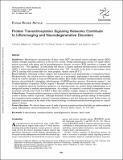Protein Transnitrosylation Signaling Networks Contribute to Inflammaging and Neurodegenerative Disorders
Author(s)
Nakamura, Tomohiro; Oh, Chang-ki; Zhang, Xu; Tannenbaum, Steven R; Lipton, Stuart A
DownloadPublished version (603.2Kb)
Publisher Policy
Publisher Policy
Article is made available in accordance with the publisher's policy and may be subject to US copyright law. Please refer to the publisher's site for terms of use.
Terms of use
Metadata
Show full item recordAbstract
Significance: Physiological concentrations of nitric oxide (NO•) and related reactive nitrogen species (RNS) mediate multiple signaling pathways in the nervous system. During inflammaging (chronic low-grade inflammation associated with aging) and in neurodegenerative diseases, excessive RNS contribute to synaptic and neuronal loss. "NO signaling" in both health and disease is largely mediated through protein S-nitrosylation (SNO), a redox-based posttranslational modification with "NO" (possibly in the form of nitrosonium cation [NO+]) reacting with cysteine thiol (or, more properly, thiolate anion [R-S-]). Recent Advances: Emerging evidence suggests that S-nitrosylation occurs predominantly via transnitros(yl)ation. Mechanistically, the reaction involves thiolate anion, as a nucleophile, performing a reversible nucleophilic attack on a nitroso nitrogen to form an SNO-protein adduct. Prior studies identified transnitrosylation reactions between glyceraldehyde-3-phosphate dehydrogenase (GAPDH)-nuclear proteins, thioredoxin-caspase-3, and X-linked inhibitor of apoptosis (XIAP)-caspase-3. Recently, we discovered that enzymes previously thought to act in completely disparate biochemical pathways can transnitrosylate one another during inflammaging in an unexpected manner to mediate neurodegeneration. Accordingly, we reported a concerted tricomponent transnitrosylation network from Uch-L1-to-Cdk5-to-Drp1 that mediates synaptic damage in Alzheimer's disease. Critical Issues: Transnitrosylation represents a critical chemical mechanism for transduction of redox-mediated events to distinct subsets of proteins. Although thousands of thiol-containing proteins undergo S-nitrosylation, how transnitrosylation regulates a myriad of neuronal attributes is just now being uncovered. In this review, we highlight recent progress in the study of the chemical biology of transnitrosylation between proteins as a mechanism of disease. Future Directions: We discuss future areas of study of protein transnitrosylation that link our understanding of aging, inflammation, and neurodegenerative diseases. Antioxid. Redox Signal. 35, 531-550.
Date issued
2021Department
Massachusetts Institute of Technology. Department of Biological EngineeringJournal
Antioxidants and Redox Signaling
Publisher
Mary Ann Liebert Inc